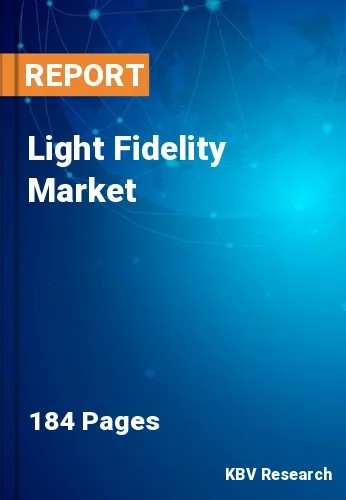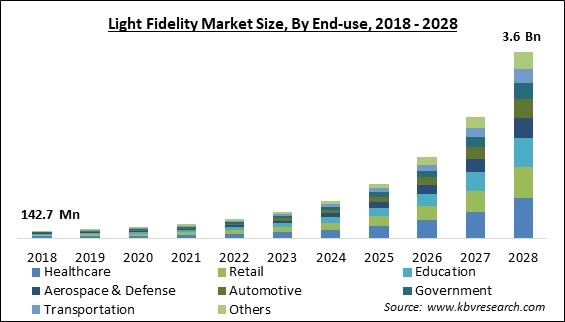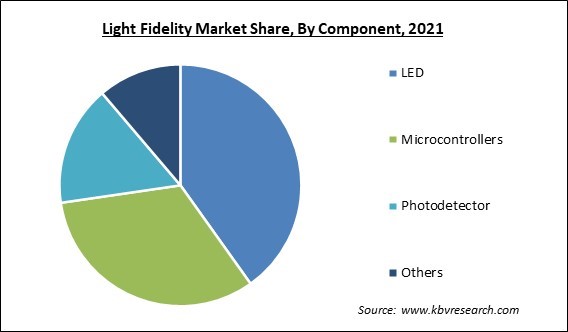
The Global Light Fidelity Market size is expected to reach $3.6 billion by 2028, rising at a market growth of 46.2% CAGR during the forecast period.
Li-Fi is a type of wireless networking that uses both visible and infrared spectrums to transmit data at fast speeds. The visible light communication (VLC) concept is expanded by Li-Fi to encompass steady, bi-directional, fast, and fully networked wireless communications. Multi-user connectivity and Device accessibility are made possible by Li-Fi. Wideband spectrum, as well as a more dependable internet connection, are provided by Li-Fi, allowing companies to handle large data demand. Distributed networks are now more necessary than ever because of the growing usage of connected devices across several industry verticals, including manufacturing, retail, healthcare, and others.

Over conventional distributed networks, Li-Fi offers several technological improvements, including faster data transmission rates, better data security, and others. Examples of contemporary wireless communication systems that use radio frequency (RF) or radio waves as the main channel for data transfer include wireless-fidelity (Wi-Fi) and Bluetooth. But, it must find ways to get through the RF band's restrictions and interference.
VLC technology, which employs visible light as a medium to enable exceptionally high-speed communication as in Wi-Fi, comes into play as a possible alternative. Li-Fi is superior to Wi-Fi regarding accessibility, bandwidth, security, and effectiveness. Wi-Fi systems cannot handle a high user density due to their restricted spectrum and extended reach, which leads to inconsistent connections in crowded areas like airports, train stations, conference centers, etc.
On the other hand, VLC systems can offer dependable wireless access throughout their range since their access to the spectrum is unregulated. Furthermore, since each LED bulb only illuminates a tiny portion of the room, it naturally creates a small access cell with only a few users, who are not required to join the access point with participants in other areas of the space. Compared to Wi-Fi, where all users must share the access point spectrum, building a large density of access points can considerably boost the network capacity for an enclosed environment with many LED lighting.
The COVID-19 pandemic had a negative impact on the communications sector. All companies around the world suffered tragically as a result of the pandemic. The need for network access at corporations and businesses was significantly reduced due to strict rules, a worldwide shutdown, and the halting of numerous commercial procedures. Li-Fi, primarily utilized in businesses, then experienced a decline in acceptance. Yet, Li-Fi technology was used in the healthcare sector during the outbreak. Li-Fi allowed for remote patient monitoring using visible light communication, considerably lowering the health risks for medical professionals. This helped in pushing the development of this technology.
LED is a key player in the comprehensive light fidelity market since it is a crucial component of Li-Fi systems. Because of its low consumption of power, lack of toxic emissions, and improved illumination, LED usage is being advocated all over the world. Governments in several nations subsidize the cost of LED lights, which has resulted in a significant drop in price over the past few years. This has also aided in the expansion of LED usage, even in remote locations and underdeveloped nations. The advantages of LED lighting over traditional lighting systems have also increased its use in developing countries.
The potential for Li-Fi-based applications grows together with the deployment of LED lighting in buildings. Residents of smart homes or buildings can browse the internet without additional gear as long as they are close to an LED lamp. Furthermore, Li-Fi can access the internet instead of other RF waves that would cause overlapping signals to monitor the patients. Due to issues with overlapping radio waves, there is a prohibition on mobiles in select hospital settings. This may additionally be avoided by adopting Li-Fi in the hospitality systems. All these elements are aiding in expanding the light fidelity market during the forecasted period.

Li-Fi LEDs could be reduced to below human perception while still emitting sufficient light to transfer data, even though they would need to be on to transmit data. Since technology is focused on the visible light spectrum, this is another big bottleneck because it can only be used for illumination and is not well suited for mobile communication. This is so that other light sources, like the sun, won't obstruct the signal. In order to ensure even Li-Fi distribution throughout a structure, transmitters would have to be installed in each room because Li-Fi's short wave range cannot pass through walls. Li-Fi's short range is therefore expected to hinder the market's expansion.
Based on component, the light fidelity market is categorized into LED, photodetector, microcontrollers, and others. The LED segment garnered the highest revenue share in the light fidelity market in 2021. Due to its employment in both the transmission of light and data, LED is regarded as a fundamental part of Li-Fi technology. Lighting systems were previously solely utilized to provide localized areas of illumination. Still, today's connected lighting systems combine IoT connectivity with LED capabilities to give engineers the ability to provide both illumination and data concurrently.
On the basis of end-use, the light fidelity market is divided into automotive, retail, healthcare, aerospace & defense, government, transportation, education, and others. The retail segment recorded a significant revenue share in the light fidelity market in 2021. Li-Fi technology can improve the shopping experience for customers by assisting them in navigating the store. They can use their cell phones to engage in in-store services, find specific merchandise, look for store specials, and check stock availability. Li-Fi connections from customers can also assist shops in better understanding consumer behavior and developing marketing plans as a result.
| Report Attribute | Details |
|---|---|
| Market size value in 2021 | USD 271.8 Million |
| Market size forecast in 2028 | USD 3.6 Billion |
| Base Year | 2021 |
| Historical Period | 2018 to 2020 |
| Forecast Period | 2022 to 2028 |
| Revenue Growth Rate | CAGR of 46.2% from 2022 to 2028 |
| Number of Pages | 184 |
| Number of Table | 320 |
| Report coverage | Market Trends, Revenue Estimation and Forecast, Segmentation Analysis, Regional and Country Breakdown, Companies Strategic Developments, Company Profiling |
| Segments covered | Component, End-use, Region |
| Country scope | US, Canada, Mexico, Germany, UK, France, Russia, Spain, Italy, China, Japan, India, South Korea, Singapore, Malaysia, Brazil, Argentina, UAE, Saudi Arabia, South Africa, Nigeria |
| Growth Drivers |
|
| Restraints |
|
Region wise, the light fidelity market is analyzed across North America, Europe, Asia Pacific, and LAMEA. The North America region procured the highest revenue share in the light fidelity market in 2021. The regional market expansion can be ascribed to the rising need for internet connectivity across numerous business sectors. Enterprises are also looking for connectivity solutions that offer more speed and security, encouraging the market's expansion. The development of Li-Fi in North America has been aided by the rapid advancement of communication technology, including wireless sensor connections, big data, the Internet of Things (IoT), and smartphones.
Free Valuable Insights: Global Light Fidelity Market size to reach USD 3.6 Billion by 2028
The market research report covers the analysis of key stake holders of the market. Key companies profiled in the report include Panasonic Holdings Corporation, Signify N.V., Renesas Electronics Corporation, Wipro Lighting (Wipro Enterprises Private Limited), pureLiFi Limited, Oledcomm, VLNComm, Velmenni, LiFiComm Tech, and Lucibel SA.
By Component
By End-Use
By Geography
The global Light Fidelity Market size is expected to reach $3.6 billion by 2028.
Rise in the availability of lower-priced LEDS globally are driving the market in coming years, however, Restricted range of light fidelity systems' transmission restraints the growth of the market.
Panasonic Holdings Corporation, Signify N.V., Renesas Electronics Corporation, Wipro Lighting (Wipro Enterprises Private Limited), pureLiFi Limited, Oledcomm, VLNComm, Velmenni, LiFiComm Tech, and Lucibel SA.
The expected CAGR of the Light Fidelity Market is 46.2% from 2022 to 2028.
The Healthcare segment acquired maximum revenue share in the Global Light Fidelity Market by End-use in 2021 thereby, achieving a market value of $783.5 million by 2028.
The North America market dominated the Global Light Fidelity Market by Region in 2021, and would continue to be a dominant market till 2028; thereby, achieving a market value of $1.3 billion by 2028.
Our team of dedicated experts can provide you with attractive expansion opportunities for your business.
